Related Research Articles

Harakat Ahrar al-Sham al-Islamiyya, commonly referred to as Ahrar al-Sham, is a coalition of multiple Islamist units that coalesced into a single brigade and later a division in order to fight against the Syrian Government led by Bashar al-Assad during the Syrian Civil War. Ahrar al-Sham was led by Hassan Aboud until his death in 2014. In July 2013, Ahrar al-Sham had 10,000 to 20,000 fighters, which at the time made it the second most powerful unit fighting against al-Assad, after the Free Syrian Army. It was the principal organization operating under the umbrella of the Syrian Islamic Front and was a major component of the Islamic Front. With an estimated 20,000 fighters in 2015, Ahrar al-Sham became the largest rebel group in Syria after the Free Syrian Army became less powerful. Ahrar al-Sham and Jaysh al-Islam are the main rebel groups supported by Turkey. On 18 February 2018, Ahrar al-Sham merged with the Nour al-Din al-Zenki Movement to form the Syrian Liberation Front.
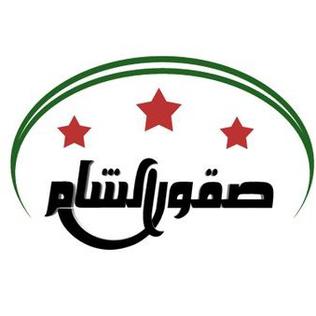
The Suqour al-Sham Brigades, also known as the Sham Falcons Brigades, is an armed rebel organisation formed by Ahmed Abu Issa early in the Syrian Civil War to fight against the Syrian Government. It was a member of the Islamic Front and a former unit of the Free Syrian Army and the Syrian Islamic Liberation Front. They have a history of coordinating with Ahrar al-Sham and al-Qaeda's al-Nusra Front, though clashes with the latter broke out in January 2017. In March 2015, the Suqour al-Sham Brigades merged with Ahrar ash-Sham, but left Ahrar al-Sham in September 2016. Also, in September 2016, they joined the Army of Conquest, of which Ahrar al-Sham is also a member. On 25 January 2017, Suqour al-Sham rejoined Ahrar al-Sham, but later became independent.

The Farouq Brigades, also spelt Farooq and Farook, was an armed Islamist rebel group formed by a number of Homs based members of the Free Syrian Army early in the Syrian Civil War. The group rapidly expanded in size and prominence in 2012, before suffering internal splits and battlefield reversals in 2013 that greatly reduced its influence. By 2014, the group was largely defunct, with member factions joining other rebel groups. The brigades were named Farouq after Omar bin al-Khattab, a Sahaba (companion) of the Islamic prophet Muhammad and the second Caliph.

The Syrian Islamic Front was an Insurgent umbrella organisation alliance of various Sunni Salafi Islamist Rebel factions against the Bashar al-Assad in Syria the organisation objective is transformation of Syria into an Islamic state under Sharia law.

The "Syrian Islamic Liberation Front" was a coalition of the Islamist rebel brigades that fought against the Syrian regime in the Syrian Civil War. At the end of 2012, it was one of the strongest military coalitions in Syria, representing up to half of the rebel forces.
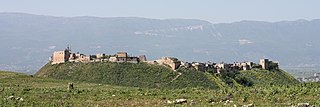
Qalaat al-Madiq is a town and medieval fortress in northwestern Syria, administratively part of the Hama Governorate, located northeast of Hama. It is situated in the al-Ghab plain, on the eastern bank of the Orontes River. Nearby localities include the district center al-Suqaylabiyah to the south, Bureij and Karnaz to the southeast, Kafr Nabudah to the east, al-Huwash to the north, Huwayjah al-Sallah and Shathah to the northwest and Al-Tuwayni and Ennab to the west. According to the Syria Central Bureau of Statistics (CBS), Qalaat al-Madiq had a population of 12,925 in the 2004 census. It is the administrative center and second largest locality in the Qalaat al-Madiq nahiyah ("subdistrict") which consisted of 40 localities with a collective population of 85,597 in 2004. The town's inhabitants are predominantly Sunni Muslims.

The Ahfad al-Rasul Brigades was a Syrian rebel group fighting against the Syrian government in the Syrian Civil War. It was funded by the Qatari government.
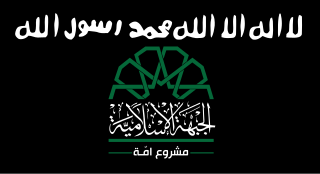
The Islamic Front was a Sunni Islamist rebel group involved in the Syrian Civil War, which was formed by the union of seven separate groups on 22 November 2013. Its three largest components were Ahrar ash-Sham, the al-Tawhid Brigade and Jaysh al-Islam. The alliance was achieved by expanding the preceding Syrian Islamic Front alliance. It was described as "an umbrella organization rather than a full union", with constituent factions continuing to serve under their own distinct leaderships.
The inter-rebel conflict during the Syrian Civil War has continued throughout the Syrian Civil War as factions of the Syrian opposition and Free Syrian Army have fought each other, with shifting alliances among various Islamist factions such as Jabhat al Nusra, Ahrar al-Sham, Jaysh al-Islam and the Islamic Front.

The Levant Front is a Syrian rebel group based around Aleppo involved in the Syrian Civil War. It was formed in December 2014.

The Fastaqim Kama Umirt Union is a rebel group active during the Syrian Civil War.

The Ajnad al-Sham was an independent Idlib and Hama-based rebel group active during the Syrian Civil War. The group is named after Ajnad al-Sham. It joined the Army of Conquest on 24 March 2015 and took part in the Second Battle of Idlib. On 29 March 2014, it announced that its military leader, Abu Abdullah Taoum, was killed during clashes around al-Fouaa.
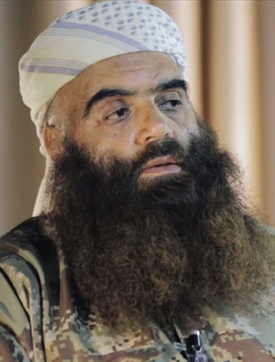
Radwan Nammous, also known by his nom de guerre Abu Firas al-Suri, was a senior official in the al-Qaeda affiliated al-Nusra Front, serving as the group's spokesman.

The Army of Victory is an armed opposition faction participating in the Syrian Civil War. Founded in August 2015 as a joint operations room of 16 member groups, three of the groups later fully merged into Jaysh al-Nasr. The group was supplied with US-made BGM-71 TOW anti-tank missiles.
The Daraa offensive was a military operation of two groups allegedly affiliated with the Islamic State of Iraq and the Levant, the Yarmouk Martyrs Brigade and the Islamic Muthanna Movement, against Syrian opposition forces in the Daraa Governorate.

The Al-Rahman Corps or Al-Rahman Legion is a Syrian rebel group that operated in Eastern Ghouta on the outskirts of Damascus, and in the eastern Qalamoun Mountains. It was the main rebel group in Jobar, and was backed by Qatar. The group's leader is Abdul al-Nasr Shamir, a captain from rural Homs who defected from the Syrian Arab Army in early 2012. The Legion has been described as an "Islamist" or as a non-Salafi "political Islamist" organisation. It describes itself as "a revolutionary military entity aiming for the downfall of the Syrian regime, seeking to create an Islamic state". In 2016, it was described as "one of the oldest standing opposition factions in Damascus and maintains high levels of local legitimacy and support." Under a surrender agreement, over 5,000 of its fighters and associated civilians left Damascus for northwestern Syria in March 2018.
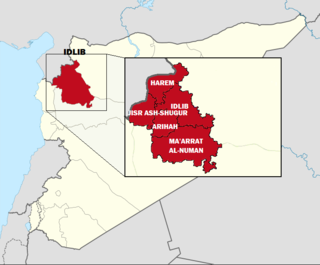
The October 2016 Idlib Governorate clashes are violent confrontations between the Salafist jihadist group Jund al-Aqsa and the Salafist Syrian rebel group the Ahrar al-Sham, supported by several other rebel groups. The two groups were previously allied during the 2016 Hama offensive, but sporadic clashes also occurred time by time.

Hay'at Tahrir al-Sham, commonly referred to as Tahrir al-Sham, is a Sunni Islamist political and armed organisation involved in the Syrian Civil War. It was formed on 28 January 2017 as a merger between Jaysh al-Ahrar, Jabhat Fateh al-Sham (JFS), Ansar al-Din Front, Jaysh al-Sunna, Liwa al-Haqq, and Nour al-Din al-Zenki Movement. The unification process was held under the initiative of Abu Jaber Shaykh, an Islamist commander who had been the second Emir of Ahrar al-Sham.
Hashim al-Shaykh, also known by his nom de guerreAbu Jaber Shaykh is a rebel commander during the Syrian Civil War who is a senior leader of Tahrir al-Sham. He had reportedly resigned from his position in Ahrar al-Sham where he served as a senior commander to help command and direct the merger. Abu Jaber is a Salafist Muslim with a jihadist ideology, which is reflected in the ideology of the group he leads.

On 19 February 2018, heavy clashes erupted between the newly established Syrian Liberation Front, which consists of Ahrar al-Sham and the Nour al-Din al-Zenki Movement, backed by the Suqour al-Sham Brigades, and Hayat Tahrir al-Sham (HTS) in the western Aleppo Governorate. The conflict soon spread to the Idlib Governorate and the SLF captured several towns from HTS. A ceasefire between the two groups was reached on 24 April 2018. Fighting again resumed on 1 January 2019, ending with a total HTS military victory on 9 January.
References
- 1 2 3 "Mmedia.me - mmedia Resources and Information". Archived from the original on 2017-12-04. Retrieved 2020-09-24.
- 1 2 3 4 Pugliese, David (13 September 2015). "War on the Islamic State – Russian forces expanding airport in Syria in preparation for new military base". Ottawa Citizen . Retrieved 18 April 2017.
- 1 2 3 4 El Deeb, Sarah (14 September 2015). "Syria group: Russia expanding major Syrian airport". Chicago Tribune . Retrieved 18 April 2017.
- 1 2 3 4 "Russia expanding major Syrian airport, monitor reports". The Japan Times . 14 September 2015. Retrieved 18 April 2017.
- ↑ Mroue, Bassem (8 October 2015). "Syrian militant group gaining influence after rebranding as moderate option". CTV News . Retrieved 18 April 2017.
- 1 2 Karouny, Mariam (22 September 2015). "Resilient insurgent group Ahrar al-Sham to play bigger role in Syria". Reuters . Retrieved 18 April 2017.
- 1 2 Ward, Olivia (5 July 2016). "Syrian rebels carry out reign of terror in north: Amnesty". Toronto Star . Retrieved 18 April 2017.
- 1 2 Tastekin, Fehim (30 September 2015). "Davutoglu proposes refugee 'container city'". Al-Monitor . Retrieved 18 April 2017.
- 1 2 Heller, Sam (30 September 2015). "Ahrar Al-Sham's Revisionist Jihadism". War on the Rocks. Retrieved 18 April 2017.
- 1 2 Lund, Aron (12 September 2015). "Abu Yahia al-Hamawi, Ahrar al-Sham's New Leader". Syria Comment. Archived from the original on 5 October 2018. Retrieved 1 October 2015.
- ↑ Aron Lund on Twitter
- 1 2 3 Decina, Alexander (1 March 2016). "In the Syrian Ceasefire Shell Game, the Good Guys May Be Bad Guys". The Daily Beast . Retrieved 18 April 2017.
- ↑ "Sources to Qasioun: Ahrar Alsham movement looking for new leader". Qasioun News. 10 November 2016. Retrieved 30 November 2016.
- ↑ El Deeb, Sarah (30 November 2016). "The Latest: Turkey says 2 soldiers missing in Syria". AP. Retrieved 30 November 2016.